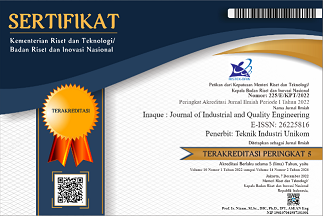PERANCANGAN STANDAR INTEGRASI SISTEM JAMINAN HALAL DAN CARA PEMBUATAN OBAT YANG BAIK
DOI:
https://doi.org/10.34010/iqe.v9i1.3946Abstract
ABSTRAK
Salah satu produk gunaan yang masih kritis mengenai jaminan halalnya di Indonesia adalah produk farmasi dan obat. Data menunjukkan bahwa obat yang telah tersertifikasi BPOM baru 13,41% yang sudah tersertifikasi halal. Sedangkan target pemerintah Indonesia mulai tahun 2019 produk gunaan halal yang beredar di Indonesia wajib bersertifikat halal, oleh karena itu dibutuhkan sebuah standar yang terdiri dari Sistem Jaminan Halal dan Cara Pembuatan Obat yang Baik. Penelitian ini menyusun sebuah standar yang mengintegrasika Sistem Jaminan Halal (SJH) dan Cara Pembuatan Obat yang Baik (CPOB) untuk membantu industri farmasi dalam mengimplementasikan kedua sistem tersebut, mengurangi redundansi dokumen dan mengefisienkan interaksi semua departemen terkait. Mengacu pada struktur ISO (International Organization of Standardization) bahwa struktur pembentukan sebuah standar adalah PDCA (Plan, Do, Check dan Act), maka penyusunan standar pada penelitian ini juga mempunyai struktur yang sama. Proses integrasi Sistem Jaminan Halal (SJH) dan Cara Pembuatan Obat yang Baik (CPOB) melalui proses analisis struktur kedua buah sistem, lalu dianalisis masing-masing klausul dan sub klausul untuk mencari kesamaan yang dapat diintegrasikan menjadikan sebuah sistem yang terintegrasi yaitu Cara Pembuatan Obat yang Baik dan Halal (CPOBH). 11 Klausul pembentuk Sistem Jaminan Halal (SJH) dan 12 Klausul Cara Pembuatan Obat yang Baik (CPOB) diklasifikasikan sesuai dengan strukturnya. Setelah proses pengintegrasian didapatkan 15 klausul di CPOBH. Beberapa klausul tambahan maupun pengganti dalam sistem yang sudah terintegrasi tidak merubah makna atau tujuan dari kedua sistem yang diterapkan.
Kata kunci: Sistem Manajemen Terintegrasi, CPOB, Sistem Jaminan Halal
ABSTRACT
One product that is still critical of its legal guarantee in Indonesia is pharmaceutical and medicinal products. Data shows that medicines that have been BPOM certified only 13,41% are halal certified. While the Indonesian government's start in 2019 for halal use products circulating in Indonesia must be halal certified, therefore a standard is needed which consists of a Halal Assurance System and The Proper Way to Produce a Good Quality Medicine. This study sets out a standard that integrates the Halal Assurance System (SJH) and the Proper Way to Produce a Good Quality Medicine (CPOB) to assist the pharmaceutical industry in implementing both systems, reducing document redundancy and streamlining the interaction of all relevant departments. Referring to the ISO (International Organization of Standardization) structure that the structure of the formation of a standard is PDCA (Plan, Do, Check and Act), then the standard arrangement in this study also has the same structure. The integration process of the Halal Assurance System (SJH) and the Proper Way to Produce a Good Quality Medicine (CPOB) through the process of analyzing the structure of the two systems, then analyzed each clause and sub-clause to look for similarities that can be integrated into an integrated system, namely the the Proper Way to Produce a Good Quality and Halal Medicine (CPOBH). 11 Clauses forming the Halal Assurance System (SJH) and 12 the Proper Way to Produce a Good Quality (CPOB) are classified according to their structure. After the integration process was obtained 15 clauses at CPOBH. Some additional clauses and substitutes in an integrated system do not change the meaning or purpose of the two systems applied.
Keywords: Integrated Management System, CPOB, Halal Assurance System
Downloads
Published
Issue
Section
License
Authors who publish this journal agree to the following terms:
The author holds the copyright and grants the right of the first publication journal to enable INAQUE to share the work with acknowledgment of the author's work and early publications in this journal.
Authors may include separate additional contractual arrangements for the non-exclusive distribution of the journal's published version (for example, submit to an institutional repository or publish in a book), with the acknowledgment of its initial publication in this journal
Authors are permitted and encouraged to post their work online before and during the delivery process, as it may lead to productive exchanges, as well as quotations of previously published and longer works








